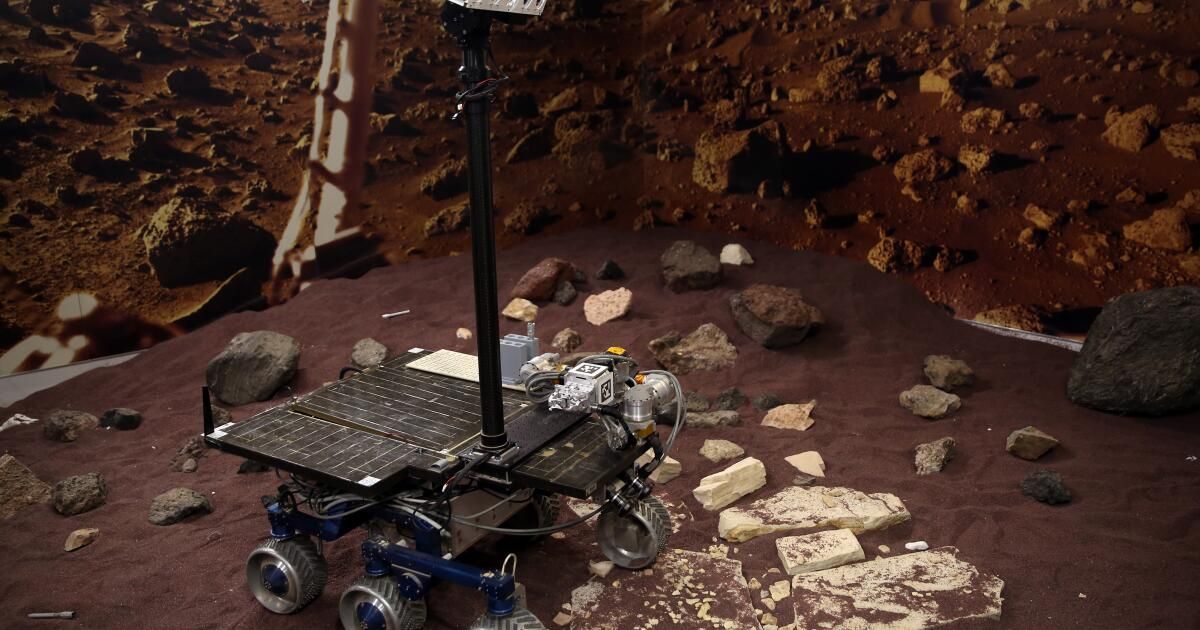The Jet Propulsion Laboratory laid off 100 contractors last week and will scale back part of the first-ever effort to bring pieces of Mars to Earth, after a NASA cost-cutting order that lawmakers called “shortsighted and wrong.”
In an email sent to staff Thursday, JPL Director Laurie Leshin said NASA is preparing for a federal budget that could limit spending on the Sample return mission to Mars to $300 million this fiscal year, just 36% of last year’s $822 million budget and less than a third of the $949 million the Biden administration requested for the program.
“Adjusting to such a large budget cut in one year will be painful,” Leshin wrote to employees at the federally funded La Cañada Flintridge research institution. “It is also increasingly likely that there will be impacts on the JPL workforce in the form of layoffs, and the way in which such actions are implemented on the JPL workforce means that the impact would not be limited to MSR.”
This week’s layoffs of contract employees along with a hiring freeze are part of a lab-wide effort to reduce spending, Leshin wrote. In addition, NASA has ordered JPL to cease operations at the end of this month in a key project within the mission to bring a piece of Mars back to Earth, a joint project with the European Space Agency and one of the missions larger and more complex. performed in the laboratory.
Work on Mars sample return Capture, Containment and Return System will pause while an independent review team analyzes the overall design of the long-awaited mission to collect dust and rocks from Mars and bring them to Earth for study, Leshin wrote.
“These are painful but necessary adjustments as we work in the current budget environment while striving to maintain our unique skills and world-class workforce for NASA and our nation,” JPL said in a statement.
The cuts come as Congress is still debating how it will distribute the fiscal year 2024 budget.
Lawmakers have criticized the agency’s decision to reduce personnel and science in the Mars effort before final numbers are known.
“NASA’s unprecedented and unilateral decision to cut funding for the Mars Sample Return mission, before Congress has completed its appropriations process, is having devastating real-world consequences,” Rep. Adam Schiff said Friday. . “This critical mission was identified as NASA’s top science priority by the decennial surveyand backing down now will mean giving up important American leadership in space science.”
The sample recovery lander was originally scheduled to lift off in 2028, with a planned return to Earth in 2033 after the first rocket launch from another planet.
A independent review of the project that NASA commissioned last year found that the mission “was not designed to be managed effectively” and that there was a “near zero chance” that it would reach its launch date in 2028. Even meeting a launch date Postponed launch to 2030 would require more than $1 billion a year for at least three years starting in 2025.
The mission’s final price tag could be nearly $10 billion, the review concluded, more than double the $4.4 billion estimated in 2020.
california legislators they have pressed to preserve JPL funding, citing the need to protect jobs and keep the American space program competitive. China has announced its own sample return mission to be launched in 2028 or 2030: an outlook, the review indicatedthat would “challenge America’s technical, engineering, and scientific leadership in Mars exploration.”
In a letter from november To NASA Administrator Bill Nelson, a bipartisan group of six California lawmakers in the U.S. House and Senate said they were “baffled” by NASA’s preemptive adjustment before a final budget was announced.
Implementing NASA-mandated cuts means JPL “will be unable to meet the 2030 launch window, billions of dollars in contracts supporting American businesses will be subject to cancellation, and hundreds of high-skilled jobs will be lost.” in California,” they wrote. “If this exceptionally talented workforce is lost to the private sector, it will be nearly impossible to bring it back together.”
In the most recent decadal planetary science surveyIn a report prepared for NASA every 10 years by the National Academy of Sciences, Engineering and Medicine, planetary scientists named the Mars Sample Return mission as the “highest scientific priority of NASA’s robotic exploration efforts this decade” and They argued that the program should be completed “as soon as practically possible without increase or decrease in its current scope.”
But the authors cautioned that the ambitious mission should not come at the expense of other planetary science.
“Mars sample return is of critical strategic importance to NASA, American leadership in planetary science, and international cooperation and must be completed as quickly as possible.” the report said. “However, its cost must not be allowed to undermine the long-term programmatic balance of the planetary portfolio.”
These tubes contain samples of rock cores and regolith (broken rock and dust) collected by NASA’s Perseverance rover for the Mars Sample Return campaign, which aims to bring Martian samples to Earth for more detailed study.
(NASA/JPL-Caltech/MSSS)












